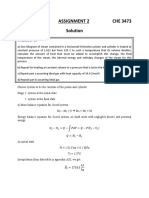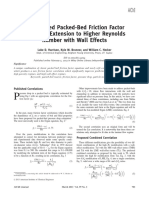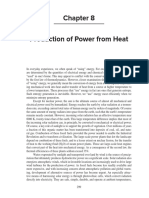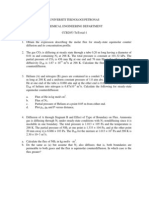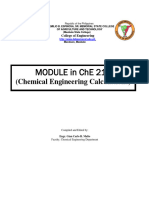Uploaded by
Jessica SaballeroUploaded by
Jessica Saballero13-19(F)/300 Water is heated in a copper tube of 1/D at a pt.
along the tube the average temp. is 100F and the tube wall temp.
Is 210F. Calculate the heat transfer coefficient and the heat flux for
a water velocity at 5 ft/s.
4.5-1(G)/240 Air at 206.8 kPa and an average of 477.6 K is being
treated as it flows through a tube of 25.4 mm inside diameter at a
velocity of 76.2 m/s. The heating medium is 488.7K steam
condensing at the outside of the tube. Since the heat transfer
coefficient of condensing steam is several thousand Wm2K and the
resistance of the metal wall is very small, it will be assumed that the
surface wall temperature of the metal in contact with air 488.7 K.
Calculate the heat transfer flux.
Calculate the rate of heat by convection of 2 sch 40 pipe at 120C
to the surrounding air at 30C. Express the answer n W/m length of
pipe. (horizontal arrangement)
Calculate the net interchange of radiation between a 2 sch 40
oxidized steel pipe at 120oC and a big room whose wall temperature
is 30oC.
13.20(F) /300 Air at atmospheric pressure and an average
temperature of 100F is flowing at 10,000ft3/min through a 3
circular duct. The wall temperature is 300F. Calculate the heat flux.
13.20(F) /300 Air at atmospheric pressure and an average
temperature of 100F is flowing at 10,000ft3/min through a 3
circular duct. The wall temperature is 300F. Calculate the heat flux.
Determine the net heat transfer by radiation bet. Two surfaces A &
B, expressed in Watts. If the temperature A & B are 700 K & 300 K,
respectively.
a) Surfaces A& B are infinitely parallel planes (stainless steel) of
b) Surfaces A is a 6mx2m oxidized aluminum plate & B is a
double row of staggered Cu pipe 4 cm in diameter, 2 m long
set on an 8 cm pitch.
c) Surfaces A & B are concentric oxidized steel pipes 10 cm and
12 cm in diameter respectively & 2 m long.
Paddle agitator w/ no baffles
a= 0.36, b=2/3, m=0.21, Nre= 300- 3x105
Flat blade turbine agitator w/ no baffles
a= 0.54, b=2/3, m=0.14, Nre= 30- 3x105
Flat blade turbine agitator w/ baffles
a= 0.74, b=2/3 m= 0.14, Nre= 500- 3x105
Anchor agitator w/ no baffles
a= 1.0, b= 1/2 , m= 0.18, Nre= 10-300
a= 0.36, b= , m= 0.18, Nre= 300- 4x104
Helical ribbon agitator w/ no baffles
a= 0.633, b= , m= 0.18, Nre= 8x105
Paddle agitator w/ no baffles
a= 0.36, b=2/3, m=0.21, Nre= 300- 3x105
Flat blade turbine agitator w/ no baffles
a= 0.54, b=2/3, m=0.14, Nre= 30- 3x105
Flat blade turbine agitator w/ baffles
a= 0.74, b=2/3 m= 0.14, Nre= 500- 3x105
Anchor agitator w/ no baffles
a= 1.0, b= 1/2 , m= 0.18, Nre= 10-300
a= 0.36, b= , m= 0.18, Nre= 300- 4x10 4
Helical ribbon agitator w/ no baffles
a= 0.633, b= , m= 0.18, Nre= 8x105
A jacketed vessel 1.83m diameter agitated vessel w/ baffles s being
used to heat a liquid w/c is at 300K. The agitator is 0.61m in
diameter and s a flat-blade turbine rotating at 100 rpm. Hot H2O is
in the heating jacket. The wall surface temp is constant at 355.4K.
Calculate the heat transfer coefficient.
A heat exchanger is to be designed to cool oil from 450 oF to 225oF
by passing it through 1 ID tubes at a velocity of 5 ft/s. Another oil
will flow outside the tubes and will be heated from 100 to 400 oF. If
the overall coefficient of the heat transfer is assumed constant at
50, calculate the length of each tube (i.e, sum of all passes)
required in the following cases:
a. For a double pipe countercurrent H.E
b. For a baffled H.E with 3 shell passes & 6 tube passes
c. For a baffled H.E with 6 shell passes & 12 tube passes
The density and specific heat of both oils may be taken as 55
lbm/ft3 and 0.5 BTU/lb-oF, respectively.
Air for a furnace is preheated from 70degF to 120degF in a
preheater, flue gases are cooled from 450degF to 300degF. Air
enters at 2000 scfm. The U= 35 BTU/hrft2oF. Determine the
corrected LMTD & the required area for a flow pattern.
a. 1-2 shell & tube counterflow
b. Single pass cross flow, both streams are mixed
c. 2-4 shell & tube counterflow
d. Single pass cross flow, air mixed and gas unmixed
You might also like
- A Combined Packed-Bed Friction Factor Equation Extension To Higher Reynolds Number With Wall EffectsNo ratings yetA Combined Packed-Bed Friction Factor Equation Extension To Higher Reynolds Number With Wall Effects4 pages
- Work and Energy: Part A. Vocabulary ReviewNo ratings yetWork and Energy: Part A. Vocabulary Review2 pages
- Faculty of Engineering and The Built Environment (Febe) Department of Chemical Engineering Unochb2: Unit Operations 2B TUTORIAL 4-EvaporationNo ratings yetFaculty of Engineering and The Built Environment (Febe) Department of Chemical Engineering Unochb2: Unit Operations 2B TUTORIAL 4-Evaporation2 pages
- Final Question Bank MT 1 3rd Sem Internal 1No ratings yetFinal Question Bank MT 1 3rd Sem Internal 111 pages
- Appendix C: Multiple Choice Questions..: Cus O H O H O H ONo ratings yetAppendix C: Multiple Choice Questions..: Cus O H O H O H O27 pages
- Chapter 4 - Stage and Continuous Gas-Liquid Separation ProcessesNo ratings yetChapter 4 - Stage and Continuous Gas-Liquid Separation Processes48 pages
- Gas Absorption - A Soluble Vapor Is Absorbed From: Liquid Adsorbent Below Its Bubble PointNo ratings yetGas Absorption - A Soluble Vapor Is Absorbed From: Liquid Adsorbent Below Its Bubble Point16 pages
- Process Dynamics & Control: Muhammad Rashed JavedNo ratings yetProcess Dynamics & Control: Muhammad Rashed Javed33 pages
- Feed Oversize Product Undersize Screen MeshNo ratings yetFeed Oversize Product Undersize Screen Mesh3 pages
- Problem Set - Day 2 Chemical Engineering PrinciplesNo ratings yetProblem Set - Day 2 Chemical Engineering Principles26 pages
- CHE4162 Particle Technology November 2010 Exam Solutions100% (1)CHE4162 Particle Technology November 2010 Exam Solutions14 pages
- Practice Problems:: Chapter 10, Problems 7, 16, 17, 18 Chapter 11, Problems 1, 2, 3, 21, 22, 28No ratings yetPractice Problems:: Chapter 10, Problems 7, 16, 17, 18 Chapter 11, Problems 1, 2, 3, 21, 22, 2843 pages
- Molecular Transport Equation and General Property Balance100% (1)Molecular Transport Equation and General Property Balance56 pages
- Solution Thermodynamics: Applications: Chapter 12-Part IIINo ratings yetSolution Thermodynamics: Applications: Chapter 12-Part III14 pages
- Instant Access to Unit Operations of Chemical Engineering, 7th Edition, solutions manual only Warren Mccabe ebook Full Chapters100% (3)Instant Access to Unit Operations of Chemical Engineering, 7th Edition, solutions manual only Warren Mccabe ebook Full Chapters55 pages
- Topics: Psychro. Evaporative, Cooling & Solids Drying Energy Resources Conversion & UtilizationNo ratings yetTopics: Psychro. Evaporative, Cooling & Solids Drying Energy Resources Conversion & Utilization3 pages
- Introductory Applications of Partial Differential Equations: With Emphasis on Wave Propagation and DiffusionFrom EverandIntroductory Applications of Partial Differential Equations: With Emphasis on Wave Propagation and DiffusionNo ratings yet
- Approval Sheet: Melongena (Eggplant) Peel and Synthesized TioNo ratings yetApproval Sheet: Melongena (Eggplant) Peel and Synthesized Tio1 page
- Instruction For Obe Requirement For Computer ApplicationsNo ratings yetInstruction For Obe Requirement For Computer Applications1 page
- Grain Size Effect On Structural, Electrical and Mechanical Properties of NiTi Thin FilmsNo ratings yetGrain Size Effect On Structural, Electrical and Mechanical Properties of NiTi Thin Films8 pages
- EMERSON - Fisher - Data Sheets-627-Series-Pressure-Reducing-RegulatorsNo ratings yetEMERSON - Fisher - Data Sheets-627-Series-Pressure-Reducing-Regulators38 pages
- Heat Recovery Ventilator: LG Air ConditionersNo ratings yetHeat Recovery Ventilator: LG Air Conditioners47 pages
- Chiller Water Carrier AquaForce 30XW (225 300 Ton)No ratings yetChiller Water Carrier AquaForce 30XW (225 300 Ton)4 pages
- Standards Comparison Steels For Offshore StructuresNo ratings yetStandards Comparison Steels For Offshore Structures9 pages
- Vacuum Condenser Drainage - Proper Design & Installation GuideNo ratings yetVacuum Condenser Drainage - Proper Design & Installation Guide3 pages
- Sii Asi 772136a Cessna 350 400 Rev G Final100% (1)Sii Asi 772136a Cessna 350 400 Rev G Final45 pages
- Copeland Refrigeration Manual Part 2 Refrigeration System ComponentsNo ratings yetCopeland Refrigeration Manual Part 2 Refrigeration System Components64 pages
- Usp-Nf (1229.4) Sterilizing Filtration of LiquidsNo ratings yetUsp-Nf (1229.4) Sterilizing Filtration of Liquids7 pages
- Elastomeric Bearing Type B According To En1337 Hand CalcNo ratings yetElastomeric Bearing Type B According To En1337 Hand Calc4 pages
- Optimum Tension Levelling of Sheet Metal BronxNo ratings yetOptimum Tension Levelling of Sheet Metal Bronx6 pages
- Dynamic Response Of: Multi-Degree-of-Freedom (MDOF) Systems or StructuresNo ratings yetDynamic Response Of: Multi-Degree-of-Freedom (MDOF) Systems or Structures34 pages





